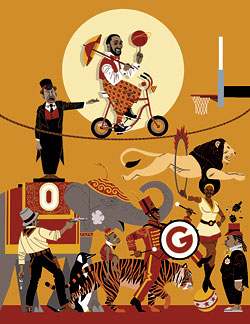
Illustration by Jacob Weinstein; Courtesy of Bloomsbury USA.
I believe, fervently, fundamentally, irrationally—like a big-tent revivalist speaking in tongues—in the deep spirituality of basketball. The game belongs in the same experiential category as space exploration, planting gardens, raising children, watching sunrises from 12,000-foot peaks, solving impossible math problems, and making emotional connections with lost animals. It is the ancient primal language in which the universe speaks human truth most plainly. My first sustained exposure to basketball was literally religious. As an adolescent I would skip church services along with the pastor’s son, sneak off to a nearby Sunday-school room, fire up the big TV on its rolling metal cart, and (primed by NBC’s theme music, the now-legendary John Tesh hymn “Roundball Rock”) sit down to earnestly study the feverish catechism of the early-nineties NBA—the heroism, villainy, violence, sacrifice, treachery, faith, and wisdom of Barkley, Stockton, Wilkins, Jordan, Pippen, Ewing, Rodman, Moncrief. After several pious months, this secret worship led to a spiritual transfer in which basketball supplanted Lutheranism as the official mythology of my youth. It succored me in times of hardship. When I got bullied in high school, I shot hundreds of free throws like someone reciting rosaries. I came to believe that the health of your jumper’s arc, the purity of your ball rotation, was a precise measure of your spiritual worth. When I tried out for my high-school team, it seemed that so much was at stake about my soul and its place in the universe that, before we’d even had a chance to run the first drill, I projectile-vomited all over the gym floor. (I didn’t make the team.)
I have carried this devotion, somewhat ambivalently, into adulthood. I navigate subway-station crowds using basketball angles; I teach students compulsively through basketball metaphors; I fantasize about basketball as I’m falling asleep. At least once or twice a year, my hatred of Kobe Bryant causes me actual physiological distress. Two decades ago, such single-minded asceticism might have meant a lonely path—a futile lifelong search for congregations of similarly overinvested people. Fortunately, however, we live in a time of spiritual enlightenment, and the Internet is swarming with intelligent, passionate, active, faith-based basketball communities. It strikes me as no coincidence that my favorite basketball blogger, “Dave” from the Portland Trailblazers fan site BlazersEdge—whose essays I read more consistently and happily than those of most professional columnists—also happens to be a pastor.
The apotheosis of online basketball overanalysis, though, is a blog called Free Darko: a cabal of eggheads, led by the pseudonymous analyst Bethlehem Shoals, who pore over contemporary league mythology with advanced theoretical tools—statistical, philosophical, poetic, psychoanalytic. (The blog’s title refers to Darko Milicic, one of the game’s most spectacular draft busts, a gawky Serbian teenager picked apparently on the basis of magical superpowers that he has since chosen to conceal.)
Free Darko’s new book, The Macrophenomenal Pro Basketball Almanac, promises to be a bible for the overeducated basketball junkie. It isolates a handful of the current NBA’s most intriguing stylists (Kobe, LeBron, Yao Ming) and subjects them to a sustained flurry of unorthodox methodology. Each player is assigned a free-associative “spirit animal”: Stephon Marbury is a prairie vole, Rasheed Wallace an Egyptian mongoose, and Chris Paul a Mindoro stripe-faced fruit bat. Unusual data sets are plotted on baroque charts and graphs: We learn, for example, that Gilbert Arenas’s three-point percentage counterintuitively improves the farther he is from the basket. The book’s core is a series of poetic-analytic treatises on various players. Tim Duncan—four-time champion, perpetual All-Star, incurable dullard—proves that an “absence of style can be style in and of itself.” He is an “automaton of success” who faces down defenders with “the saucerlike eyes of a German shepherd,” and his blandness leads the authors into deep existential territory: “Can Duncan feel pain? … Does Duncan love? … Do the concepts of free will or consciousness mean anything to him?” They find, ingeniously, that his statistics line up with the Fibonacci sequence—the mathematical pattern that governs the growth of pinecones, sunflowers, and seashells. The book is loaded with surreal juxtapositions, precisely overblown language, and pithy summations of complex styles. Carmelo Anthony is an “on-court classicist” who “works through possessions like logic puzzles.” The erratically violent Ron Artest represents “the continual dry-humping of the apocalypse.” Vince Carter is possibly a sociopath. A Gilbert Arenas dunk is like a sand dollar—“irrelevant, though not unpleasant.”
How smart, finally, is Free Darko? The answer varies from page to page. Dazzling conclusions (“The dunk was, and still is, the crack cocaine of the NBA”) sit side-by-side with jokey, arbitrary, pointless knowledge mash-ups (Marbury’s career as a game of Parcheesi). The book seems to suffer from an essential confusion about whether it’s performing real knowledge-work—as it often does—or just parodying knowledge-work. Sometimes it reads like a virtuosic sampler of all the culture’s current favorite genres of pop analysis: the showy counterintuitions of Slate (“In the end, it may not be Rasheed who is irrational, but our decidedly grotesque opinions of him”); the fussy theorizing of n+1 (“Somehow, the high-flying, tensile McGrady never seems wholly invested in the catharsis of raw action”); the number-crunching of Nate Silver; the trend-spotting of Malcolm Gladwell. Its analyses arrive so endlessly, with such imaginative gusto, that they’re ultimately a little deadening, in a way that seems to transcend basketball and raise big questions about how we fetishize and dissect any kind of cultural pursuit in highly educated, 21st-century, online America. Quick-hit Internet intellectualism, however lushly done, inevitably starts to feel like mental channel-surfing. Even the most sacred subjects can leave us in a hopped-up, data-filled stupor.
The Macrophenomenal Pro Basketball Almanac
By Bethlehem Shoals.
Bloomsbury USA. $23.